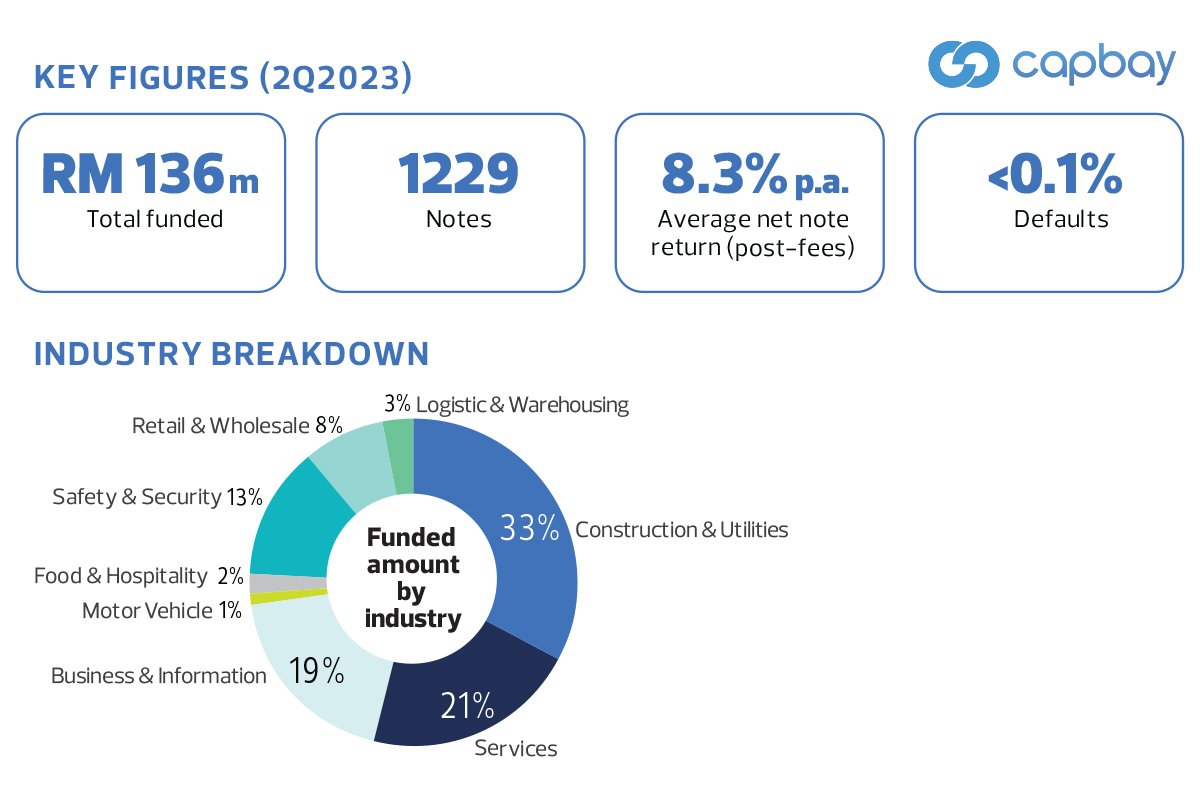
This article first appeared in Wealth, The Edge Malaysia Weekly on September 25, 2023 - October 1, 2023
Private credit, which entails non-bank lenders providing credit to small and medium enterprises (SMEs), is experiencing a boom, says Ang Xing Xian, CEO and co-founder of peer-to-peer (P2P) financing firm Capital Bay Sdn Bhd (CapBay).
“If you talk to the asset managers in town, you’d find most of them would have already been offering private credit [investments] to investors over the past few years through private mandate,” he says.
In an interview with Wealth, Ang says the private credit industry has been growing rapidly since the pandemic struck in 2020. As banks pulled back on lending to preserve capital, alternative financing players, including P2P financing platforms, dove in to fill the gap.
According to Securities Commission Malaysia (SC), P2P raised RM1.58 billion across 24,455 campaigns last year, representing a 38% increase in its financing amount. The strongest growth was in 2021, when total funds raised hit RM1.14 billion, more than double from RM512.65 million in the previous year.
The strong growth observed in the P2P financing sector could also be due to the underperformance of the equity market in 2021 and 2022, partly reflected through the performance of the FBM KLCI, says Ang.
Fixed income investment instruments, such as bonds, tend to perform well when equities don’t. But that didn’t happen last year, leaving investors with few places to hide. Some investors piled their money into P2P.
“I think it (growth of P2P) stems from the equity market doing badly. This can be seen through larger-size companies delaying their IPOs or private placements. But they still need money. So, [even] they go to the private credit [market].
“P2P worked well for investors during that period, too, because the returns are good and stable, unlike equities which are very volatile,” says Ang.
The default rate, at least for CapBay, has also been low. As at August, the platform default rate is lower than 0.1%, according to its official website.
Based on the SC’s definition, defaults occur when repayments by the issuers/borrowers are not made within a stipulated time from the agreed repayment date, which is typically 90 days.
Meanwhile, the average net return of its investors is 8.2% per annum (according to its official website), which is attractive even when compared to the prevailing fixed deposit rate of above 3%.
Some investors also like putting money into P2P financing as the asset class is not mark-to-market, which means its fair value is not measured over time like other asset classes. Investors merely hold those financing notes until they mature and get the returns when defaults do not happen.
As a result, Ang says CapBay has emerged as a prime beneficiary of the ongoing private credit boom. According to him, the firm raised about RM395 million last year, equivalent to RM1 for every RM4 raised through the P2P financing industry.
In July this year, CapBay achieved another milestone by providing RM1 billion in funding to more than 400 underserved SMEs in Malaysia through the issuance of 7,600 investment notes.
In the first quarter of this year (1Q2023), CapBay disbursed more than RM106 million in financing across 979 investment notes. Its total funds raised this year seem to be on track to reach new heights if the momentum continues.
Direct link to GLCs to minimise default risk
One might well ask: How does CapBay keep its default rate so low when some P2P platforms have seen their rates climb during the pandemic?
Ang says a key factor is that the platform focuses on invoice financing notes, which are short-term notes that last for one to three months. For comparison, some P2P platforms focus on term financing notes that come with a tenor of 12 to 36 months.
Another reason is that CapBay’s online platform is directly linked to various government-linked companies (GLCs) that purchase products and services from SMEs that raise funds from the platform. With this, the firm can verify and monitor the products and services these SMEs render to their GLC clients.
For instance, CapBay can verify all the historical and current work a construction company has done and is doing for a GLC. With further research and analysis, CapBay would then decide to distribute the funds it raised from investors to the construction company in advance, but at a discounted amount to the full value of the work the company provides to its client.
When the construction company completes its work for GLC clients, CapBay will then receive the full amount directly from the GLCs, instead of from the SMEs. This lowers the default risk of CapBay and its investors while making a profit.
“We work with the GLCs, some directly and others indirectly, where they would come to our platform to approve their payments. So, the risk of default is minimal as we deal directly with the paymasters of the SMEs and not the SMEs themselves.
“Also, because the businesses that come to us are smaller-size SMEs, they might not have access to the banks. They don’t mind coming to us and giving us a slightly higher [profit] rate for access to financing,” says Ang.
While some other P2P financing platforms have a similar business model, CapBay is the most specialised in dealing with GLCs and their SME product and service providers.
“All players try to do a bit of this. But for us, this is our main focus. We are the most specialised in this area. This is also why our [supply chain financing] platforms are used by multiple banks,” he adds.
Ang says the firm focuses on issuers/borrowers with lower credit risk that offer relatively lower returns. Such a strategy is different from that used by some of its peers that extend credit to businesses with higher credit risk and higher returns. This has been a message CapBay has been conveying to its investors since early days.
CapBay only accepts clients with a minimum investment amount of RM10,000, which means they tend to be wealthier and more financially savvy, in general. They are also more cautious and don’t mind sacrificing some returns for a lower default rate.
“Our minimum is RM10,000. On average, our investors put in RM30,000 to RM45,000. Most funds come from sophisticated and institutional investors, including asset managers. They don’t ask for double-digit returns, but only seek a lower default rate,” says Ang.
Having a client pool that understands its investment strategy allows CapBay to focus on its core strength.
“We want to foster a virtuous cycle. The moment we establish a lower default rate, investors can accept lower returns. That allows us to find more lower-risk customers, which then [allows us to further] lower the default rate.
“If you start going down the credit curve, you will immediately get hit by default. As a result, investors get scared and insecure. And they start demanding higher returns, which causes the default rate to go up,” he says.
Yet, how long can CapBay keep its default rate at such a level? Does a P2P platform like CapBay perform stress tests like banks do?
While there is no definite answer to this, Ang says the platform’s long-term goal is to keep its default rate below 1%. “For us, the long-term target for default rate should always be kept below 1%. We would not go down the credit curve to grow our business.”
Ang adds that P2P platforms are not required to perform stress tests like banks. But investors can assess their reliability by observing their default rates and solvency during the pandemic.
“We went through a ‘stress test’ during the Covid-19 period, right? I think the easiest way for investors to assess our capability is to compare how we performed during and after the pandemic. Of course, you can’t compare those that only started operating their business post-pandemic,” he says.
Ang adds that the platform launched CapBay Assure in July 2021, a programme that protects investors’ principal and interest through a reserve fund while ensuring net returns of up to 6% per annum.
Slightly similar to how a bank operates, the reserve fund maintains a minimum capital ratio of 8%. It simply means that the fund holds 8% of cash against the total amount it lends at all times.
“Currently, we set aside more than 10% with a default rate of just only 0.8% [for CapBay Assure products]. This means that there won’t be a situation where you have a big default and some investors see their money wiped out,” says Ang.
Regional expansion and M&A
Ang is looking to further expand CapBay’s business regionally and seeking merger and acquisition (M&A) opportunities locally and in Southeast Asia.
“Regionally, we have already started in Thailand and Singapore since early this year. That’s already activated. We are actually looking at a few other countries now,” he says.
CapBay wants to focus on the area of supply chain financing, in particular cross-border financing, when expanding into other countries in the region. The opportunities are ample.
“We see a lot of opportunities, such as a Thai [smaller-size] company wanting to sell its products to Malaysia, and that particular trade can be hard for banks to finance.
“We could do it as we have been in this area for so long. We may be able to finance it without having to compete with the banks for the rates, and generate higher returns with lower risk to our investors. This is a unique asset class that we’ve been working on,” says Ang.
Locally, Ang is planning to enhance the firm’s technological capabilities and ecosystem by utilising artificial intelligence. It is his hope that the firm can crunch numbers better to analyse risk and returns and connect its platform more seamlessly to its business partners.
“The whole point about AI nowadays is not just about numbers, but also the ecosystem. We want to build a good ecosystem with our partners, marketplace and invoice financing industry players.
“Over time, with more and more data, CapBay will be able to do more for our investors and businesses by utilising technologies like AI in order to actually assemble a much better portfolio,” Ang says.
Is CapBay looking to acquire its competitors locally?
Ang says he is more keen on acquiring a foreign outfit that would help him make inroads into new markets.
“[I am less keen on] local players, unless they can really add value to us. For instance, if it has a stronghold in a strategic sector that we want to have exposure to and it can give us a lot of data. We don’t mind an M&A with minority investment,” says Ang.
Save by subscribing to us for your print and/or digital copy.
P/S: The Edge is also available on Apple's App Store and Android's Google Play.

